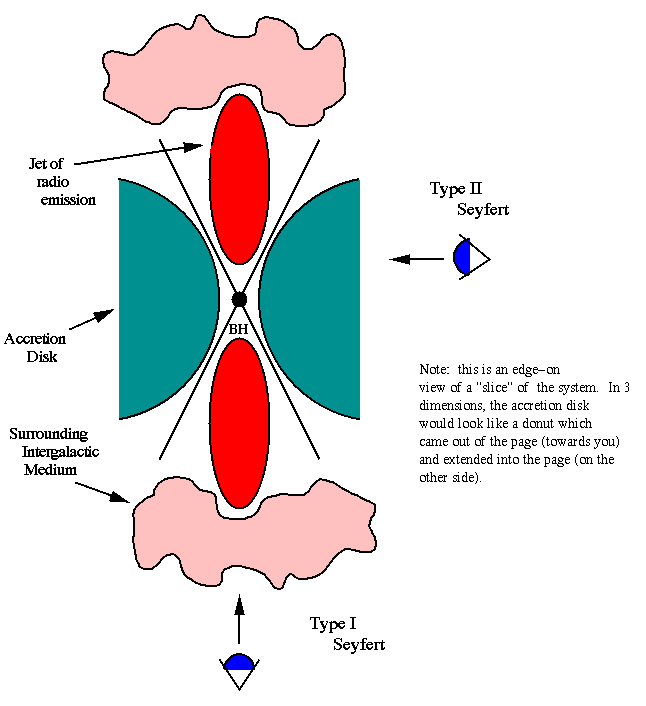
NGC 5033 is a low luminosity Seyfert type 1 galaxy with a very pronounced spiral structure and nuclear bulge. It has many similarities to the Milky Way. A massive galaxy, NGC 5033 carries the equivalent mass of two trillion suns and appears to harbor a substantial dark matter halo accounting for its great mass. NGC 5033 has a giant neighbor, another Seyfert galaxy, NGC 5005 which has most likely influenced its structure during the course of its formative history. As a Seyfert type AGN (active galactic nucleus) emission lines are observed arising from the core which do not have a stellar origin but are believed to be produced by an accretion disk dumping mass into a massive black hole.
The physical structure of the AGN region is a topic of great importance for the understanding of galactic structure and behavior. In the Unified Model of AGN, all AGN's observed have the same basic structure but the differences we see depend on the angle of the system to the observer. The basic structure starts from the innermost region where an accretion disk dumps matter into a supermassive black hole that may harbor up to a billion or more solar masses. As the material spirals in, jets of heated matter are ejected that move at velocities close to the speed of light. The inner region is only a few light days across. Moving out to about 100 light days the entire complex is encased in a cloud called the "broad line region" (BLR). The term comes from the broad spectral lines emitted from the diffuse low ionization of the dense clouds that have formed in this region. Moving outward further to a scale of about 100 light years there exists a donut shaped cloud of opaque gas that surrounds the AGN complex which is referred to as a "molecular torus". The molecular torus is thick and opaque to light. Just outside the Torus is a thin layer of lower density gas which is known as the "narrow line region" (NLR), because of its emitted spectra which is strong in the "forbidden" lines which are generally suppressed in the higher density gases.
Knowing the physical structure astronomers can now predict what emission lines will be apparent depending on the orientation of the thick molecular torus. If we observe it edge on, the torus blocks the broad line region emission and we see only the narrow line emission. These are type 2 Seyfert AGN galaxies. If the torus is face-on, then both the broad line and narrow line emission areas are detectable. These are the so called type 1 Seyfert AGN galaxies.
Peculiar to NGC 5033 is the existence of separate distinct nuclei. The optical nucleus is located in the true dynamic center of the galaxy, however the Seyfert nucleus was found to be displaced from the optical nucleus by about 3 arc seconds. There are a number of galaxies known where the active nucleus is located off center from the true dynamic center such as M31, NGC 1068, NGC 3227, and NGC 3516. In most cases astronomers believe that a large scale galactic merger produced the conditions for separate distinct nuclei. The most likely scenario is that the Seyfert nucleus represents the captured nucleus of the less dominant galaxy which then ends up orbiting the nucleus of the primary galaxy which becomes the optical nucleus of the postmerger galaxy.
NGC 5033 shows several structural peculiarities including a 12 degree warp involving its southern spiral arm in addition to a peculiar gaseous plume arising from its southern edge. Both features are attributed to previous tidal interactions with its large neighbor NGC 5005 and two smaller dwarf galaxies, Holmberg VIII and UGC 08314. The relationship of the two dwarf galaxies to NGC 5033 is very similar to that of the Milky Way and the Magellanic Clouds and most likely has had a similar effect on its evolution. Warping has been observed in many galaxies and in most instances is attributed to prior interactions with neighboring galaxies.
